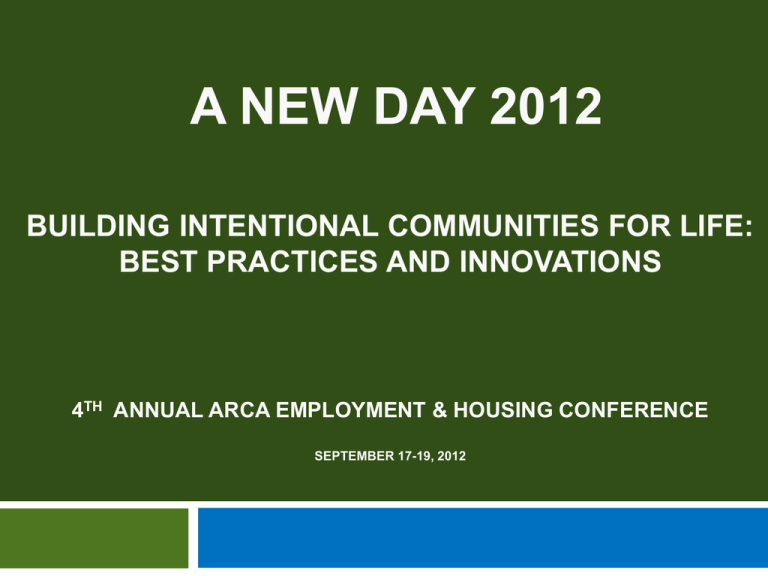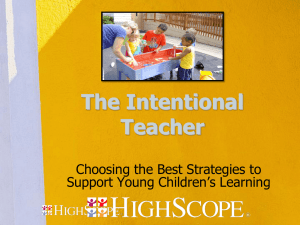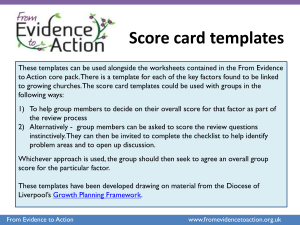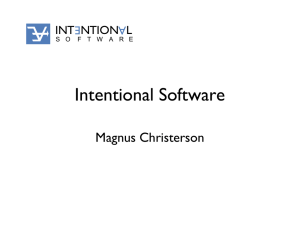Intentional Communities
advertisement

A NEW DAY 2012 BUILDING INTENTIONAL COMMUNITIES FOR LIFE: BEST PRACTICES AND INNOVATIONS 4TH ANNUAL ARCA EMPLOYMENT & HOUSING CONFERENCE SEPTEMBER 17-19, 2012 Agenda 1 Welcome ARCA Housing Principles & Goals What is an Intentional Community? Intentional Communities - National Models Starting an Intentional Community Other Critical Issues Question & Answer Session Closing Comments ARCA Housing Principles 2 Affordable housing is not a disability issue; it is a community issue. A broad range of housing options must be created in order to meet the diverse needs - includes a range of housing types, sizes, and locations. Housing should not segregate people. Housing must be affordable for people with developmental disabilities. Support services should not be tied to housing. Separate the ownership of housing from the provision of services. Use principles of Universal Design and “green” building practices ARCA Housing Goals 3 Housing Development — increasing the stock of affordable housing through set-asides, scattered site acquisition, new construction, and pooled trusts. Housing Services — educating, informing, advocating and assisting people in locating and maintaining housing. Property Management Services — related to the repairs, maintenance and upkeep of properties owned by nonprofit housing organizations. Funding Solutions — innovating financing strategies and funding programs. Enabling Choice — building a future where people with developmental disabilities have access to affordable housing of their choice, in the community of their choice, with roommates of their choice, and service provider of their choice Critical Issue 4 Housing is not just real estate !! When planning ANY type of housing consider how services and programs will be integrated with the physical property. What is an Intentional Community? A Definition 5 “Intentional Community” is an inclusive term for ecovillages, cohousing communities, residential land trusts, communes, student co-ops, urban housing cooperatives, intentional living, alternative communities, cooperative living, and other projects where people strive together with a common vision. Source - Fellowship for Intentional Community (http://www.ic.org) What is an Intentional Community? A Common Mission & Vision 6 The Mission & Vision Statements – drives almost all decision-making Sharing common values Sharing common goals & purpose Community living with rules but flexibility to allow for individuals differences, preferences & needs Collective effort & participation Not an end in itself but a TOOL on how to organize one’s life What is an Intentional Community? Variables & Options 7 Primary mission Ownership & sponsorship Services Location Staffing Funding Activities/Programs Intentional Communities - National Models 8 Bittersweet Farms - Whitehouse, OH Sweetwater Spectrum - Sonoma, CA Camphill Communities – 10 in USA Benjamin’s Hope – Holland , MI Intentional Communities Bittersweet Farms 9 Intentional Communities Bittersweet Farms 10 First farmstead model in US for adults with autism Primary mission - to positively impact the lives of individuals with autism and those whose lives they touch Ownership & sponsorship – 501(c)(3) nonprofit founded by parents and professionals (opened 1983) Services – licensed intermediate care facility, community living, habilitation and day programs – serves 45 residents Location - rural Staffing – employed by Bittersweet, Inc. Funding – Ohio DDS, US Dept. of Labor & private Intentional Communities Bittersweet Farms – Programs/Activities 11 Residential services Horticulture – greenhouses, agriculture enterprise Woodshop – operating machinery, wood products Animal care – horses, chickens, goats – gross motor skills Grounds keeping – 80 acres lawns, gardens & woods Culinary arts – meal prep, baking, catering, pesto Arts, ceramics & weaving Habilitation activities – recycling, gardening, office work Community-based employment Intentional Communities Sweetwater Spectrum 12 Intentional Communities Sweetwater Spectrum 13 Intentional Communities – Sweetwater Spectrum 14 Autism-specific & “green” designed Primary mission - to provide adults with autism an innovative, supportive residential community & challenge each individual to reach his or her highest potential. Ownership & sponsorship – 501(c)(3) nonprofit founded by parents and professionals (opens Dec. 2012) Services – unlicensed – 4 homes for 16 residents – serve the entire “spectrum” of needs & financial resources Location – 3 acres, suburban, 4 blocks to town Staffing – employed by unaffiliated SLS/ILS vendors Funding – residents pay rent, food, utilities & entertainment – SLS/ILS vendor staff paid by regional center Intentional Communities – Sweetwater Spectrum – Programs/Activities 15 Community center with media room, teaching kitchen, arts/music room, movement/exercise studio & library 1.25-acre urban farm with organic vegetable gardens, orchards and greenhouse Water activities - therapy pool & spa Coordinated volunteer system Outdoor passive and active lawn areas Animal care – chickens and rabbit hutches Assist in staff training programs & development Commitment to replication Intentional Communities Camphill Communities 16 Primary mission - to provide a nurturing and dynamic residential community where adults with developmental disabilities live, learn and work together professional caregivers and volunteers. Ownership & sponsorship – 501(c))(3) founded by Karl König and inspired by the anthroposophical teachings of Rudolf Steiner Services & Programs – 24/7 licensed residential & day programs – serves 12 residents in Soquel, CA Location – semi-rural Staffing – “co-workers” employed by Camphill Funding – staff paid by CA DDS Intentional Communities Benjamin’s Hope 17 Primary mission - to be an embracing natural setting where people with disability and the community gather for Christcentered fellowship, treatment, housing and meaningful work Ownership & sponsorship – 501(c)(3) nonprofit ministry founded by parents and professionals (opens 2013) Services & Programs – 24/7 residential & day programs – serves 24 residents plus day participants Location – 40 acres, rural Staffing – employed by unaffiliated service providers Funding – staff paid by MI DDS Starting an Intentional Community 18 • • • • How does one get started? What will make it successful? “Best practices” to emulate Advice & pitfalls to avoid Starting an Intentional Community How does one get started? 19 • • • • • • • • Establish a committed, working team Create the entity/organization & practices Determine your mission & vision Identify a property with nearby resources Identify funding sources – start-up, development & ongoing operating budgets Identify services, programs & partners Spread the word & networking Create community goodwill Starting an Intentional Community What will make it successful? 20 • • • • • • • Understand/research your target residents Provide a culture of choice & options Sustainability – financial & services Dedicated/committed families – perseverance !! Engage a diverse team/Board of skilled people Listen & learn – be flexible & adapt A sound step-by-step business plan – think long-term while planning short-term Starting an Intentional Community “Best practices” to emulate 21 • • • • • • Implement strategies to integrate residents into the community Architectural elements designed to improve the lives of residents “Green” building design Separate housing from services Allow for “aging in place” of residents Bittersweet MAPS model – Meaningful Activity, Aerobic Activity, Partnership & Structure Starting an Intentional Community Advice & pitfalls to avoid 22 • Don’t assume it is a part-time project or hobby – it is a MAJOR commitment & do hire professional help • Don’t go it alone – find a partner or others to team with • Be patient in finding the right location • Engage your neighbors & don’t underestimate possible objections • Know your laws – Lanterman Act, Olmstead, fair housing, disability rights, etc… • Engage your local politicians & bureaucrats • Remember – you cannot serve everyone • Set boundaries with your “founding” families • Don’t accept all donations – equipment, animals, plants • Tell your story from the heart and don’t be offended if not everyone shares your love of your project Other Critical Issues 23 • • • • • • • • • CA state budget considerations Funding sources (HUD, etc…) Affordability Resident employment – minimum wage goal Transportation Behavioral support Federal funding/waivers Staffing Aging residents Question & Answer Session 24 Open Discussion Closing Comments 25 • • • The Past The Present The Future






